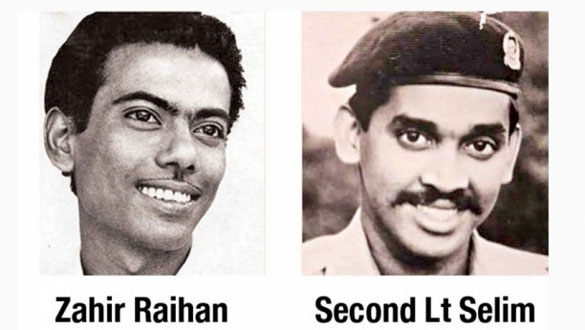Liberation Of Mirpur Was The Last Battle Of Bangladesh' Road To Independence

January 31,
2021
Across the
country, red-green flags were fluttering over buildings -- euphoria was in the
air following the end of a nine-month-long bloody war.

The
Dainik Bangla on January 31, 1972 mentioned the shooting in Mirpur.
-----
But Dhaka's
Mirpur was yet not taken by Bangladesh forces -- almost six weeks after the
Pakistan military had unconditionally surrendered to the joint command of
Bangladesh and Indian forces on December 16, 1971.
The area
remained under the control of pro-Pakistan Biharis, the Urdu-speaking Muslim
community who migrated from Bihar and West Bengal during and after the
Partition.
'Dying At The Hands Of Thieves'
It was
around 10:45am on January 30, 1972, when a group of Bangladesh Army soldiers
took position in Mirpur-12 to assist the police in the recovery of arms and
ammunition from the Biharis holding out there.
Helal
Morshed Khan, then East Bengal Regiment Delta Company's commanding officer,
thus describes the start of the battle at Mirpur nearly 50 years ago today, in
an interview with The Daily Star recently.
A chorus of
clanging noises suddenly engulfed the area, emanating from the striking of
telephone and electric poles all over.
A few
moments later, bullets started ripping through the air from what seemed like
all sides. The opposition were firing from the surrounding houses.
"There
were screams of agony as bullets tore into our men, giving them no chance for
the basic drill of dash down-crawl-observe-fire back. There was no real
cover," said Helal, also a retired major general, decorated with the
gallantry award Bir Bikram.
One bullet
hit soon-to-be-martyred Second Lieutenant Selim Mohammad Kamrul Hasan, who
Helal said fought in the Liberation War courageously and proved a leader in
battle.
The Fight Back
With the
Bangladesh army soldiers and policemen caught off-guard, many had been hit and
were either dead or gravely injured.

But after
the sudden shock, they too opened fire. A group took positions inside a house
-- half a dozen with Helal and as many with Selim, who was still firing even
after being shot.
"We
were trying to do only one thing -- not let the enemy come close to us. We also
felled scores of them," said Helal, a former chairman of Bangladesh
Muktijoddha Sangsad.
The
Bangalee soldiers held their ground -- covering the nearby lanes and were
shooting at any Bihari fighters if they came close and tried to scale the
compound walls.
Mokhlesur
Rahman, another East Bengal Regiment Delta Company member, said that he was
posted in the Mirpur-12 Panir Tank area, around 500 yards east of Helal's
position.
Bullets had
started to fall on them like rain, he told The Daily Star in a recent
interview.
Mokhles
said he saw writer and filmmaker Zahir Raihan, who is known to have accompanied
the security units to Mirpur, and some others lying shot on the road.
Journalist
Julfikar Ali Manik, in several investigation reports published by the Daily
Bhorer Kagoj in 1999, established that Zahir Raihan was shot to death in Mirpur
on January 30, 1972 when he went there in search of his brother -- writer
Shahidullah Kaiser -- who was abducted by al-Badr forces on the eve of
liberation in December 1971.
The bodies
of Zahir and many members of the security forces who died that day were never
found.
Mokhles
said at one point he saw around 60 enemy fighters coming towards them, opening
fire. Their bullets killed lance naik Nurul Islam. Mokhles then charged a
grenade and simultaneously opened fire to disperse them.
In the
afternoon, Mokhles said, he along with two other soldiers jumped into a
waterbody to lay low but was shot.
Finally,
when the sun set, he was able to leave by crossing the waterbody and was later
rescued in the early hours of the next morning by some people going to the
mosque for Fajr prayers in the Matikata area.
Helal, too,
said darkness came to his aid that day. He and some others also swam a
waterbody to reach the Balurghat area.
Selim's
brother MA Hasan, also an East Bengal Regiment Delta Company officer stationed
in the Pilkhana area during the battle, said Second Lieutenant Selim was a
brave fighter.
"In
the evening, he along with several soldiers reached Kala Panir Jheel [a local
waterbody] and encouraged the soldiers to cross it," said Hasan, who later
became a physician after leaving the army.
Selim himself
did not cross the water body as he had bullet injuries on his body, he added.
Helal and
Mokhles both said they witnessed Bihari fighters gathering the bodies of
Bangalee soldiers and hacking the bodies into pieces and then hiding them.
"They
did not want to keep any evidence," said Helal.
After the
battle, the survivors did not manage to find any of their martyred compatriots'
bodies but finally, in 1999, got some of the mortal remains -- bones and skulls
-- at the site of the Noori Mosque in Mirpur-12, Helal said.
"The
battle of Mirpur still does not have any official recognition as part of the
Liberation War. That the mortal remains of so many brave soldiers remained
traceless until 1999 was a crime," said Hasan, also convener of the War
Crimes Facts Finding Committee, Bangladesh.
On January
31, 1972, around 80 army men and 250-300 policemen had gone to Mirpur, Helal
said.
"Forty-two
soldiers of the East Bengal Regiment and we can estimate that around 80
policemen embraced martyrdom and dozens other sustained injuries," he
said.
Bihari
allies and collaborators of the Pakistani forces from every corner of the
country gathered in Mirpur and Mohammadpur areas with their weapons.
Among them
were some Pakistan army soldiers -- even commando troops members, said both
Helal and Mokhles.
A battalion
of East Bengal Regiment Delta Company later moved in and cleared the area in 10
days, recovering at least four truckloads of weapons.
The Dainik
Bangla on January 31, 1972 carried a double column news on the front page,
reporting that bullets were fired on Bangladesh forces when they went to
recover illegal arms.
The
Bangladesh Observer on February 1, 1972 reported that a large quantity of arms
and ammunition were surrendered in the Mirpur area after people there were
notified to surrender all unauthorised arms in their possession by 2:00pm on
January 31.
Both the
newspapers on February 3, 1972 also reported on "going missing of Zahir
Raihan" after he went to Mirpur.
"People
did not know what was happening in Mirpur. The focus was then on the arms
surrender ceremony at Bangabandhu Stadium. It was a secret operation,"
Helal said.
The
Mohammadpur and Mirpur areas -- full of water bodies -- were under the control
of pro-Pakistani Biharis and a relatively safe haven for Pakistani soldiers and
Al-Badr and Razakar forces to carry out atrocities and torture, said Julfikar
Ali Manik, author of the book "Muktijuddher Shesh Ronangon Mirpur".
Manik said
that pro-Pakistani Biharis were already armed and some Pakistani soldiers who did
not surrender on December 16 joined the Biharis living in Mirpur -- meaning
there were large quantities of arms in the area.
The
ultimatum to surrender arms was issued after Pakistani collaborators hiding in
Mirpur and Mohammadpur had opened fire on Bangladesh forces.
The
liberation of Mirpur was the last battle of the country's road to independence,
said Manik.
"If
you want to write the full history of the Liberation War, you cannot deduct the
battle of Mirpur."
The
government has a responsibility to officially endorse this chapter of
Liberation War -- including the martyrdom of Zahir Raihan and others who were
killed in the battle of Mirpur -- as these incidents took place in a sequel to
the nation's struggle for independence, he told The Daily Star yesterday.
This must
not be set aside as "unsolved mysteries" anymore after all these
years and there should be closure, he added.
Original Headline: The last battlefield
Source: The Daily Star
